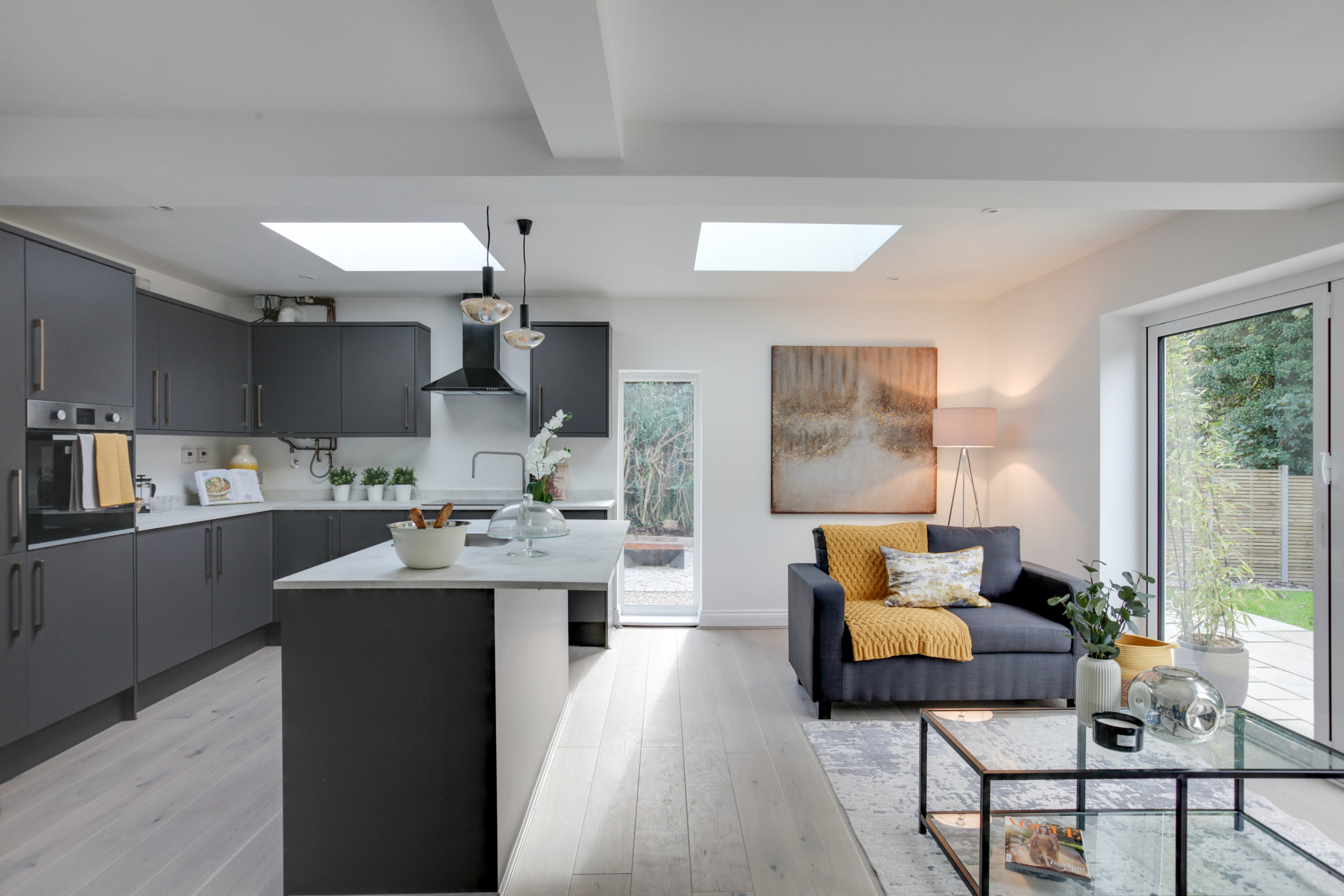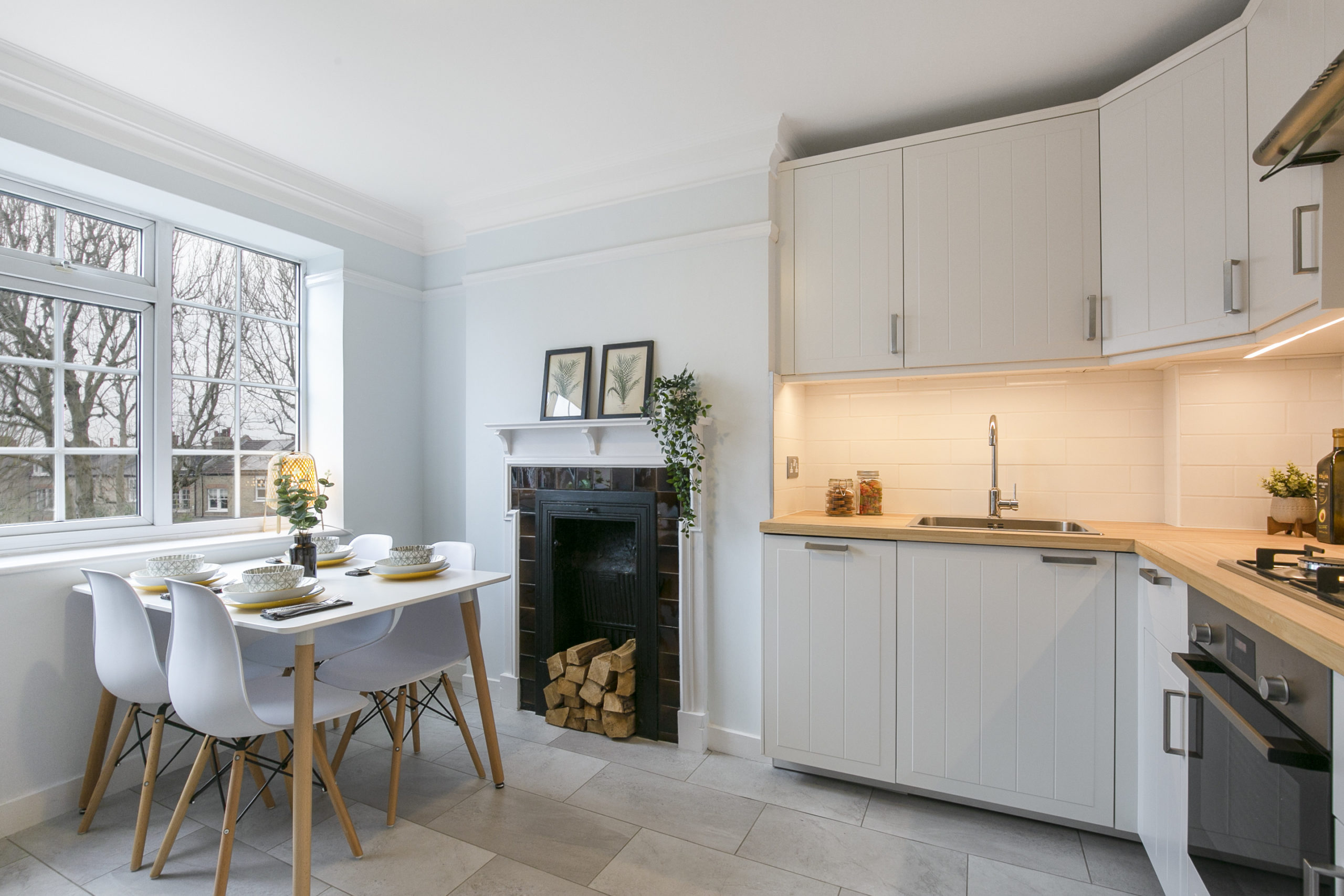
There are many benefits to an open floor plan. It’s more inviting and eases movement throughout the home. However, it can be challenging to define spaces when staging. If you don’t stage an open floor plan correctly, your home can appear awkward.
You want to show your home off to its best advantage because a vacant house, especially an open floor plan, can feel awkward and overwhelming to potential buyers. Follow the tips on staging an open floor plan to make your home irresistible to buyers. The key to staging an open floor plan is to define each space while creating a harmonious, seamless flow. Defining spaces also helps create privacy.
Keep Traffic Flow In Mind:
While you want separation in your spaces, too much variation can make the home seem thrown together and sloppy. If you stage the seating area with a rustic farmhouse design while the kitchen has an industrial, minimalist look, the home won’t make sense. Keep a similar design theme through the space, whether it’s modern, minimalist, contemporary, or rustic. This can be seen in the styles of lighting you choose, wood varieties, and accessories you use to stage an open floor plan.
When defining spaces, it’s important to keep traffic flow in mind. Try not to block any doorways or sightlines. Otherwise, things might look cramped or unpleasant to the eyes. When placing furniture, make sure there is enough space to move around it.
Use the Same Flooring Throughout:
When you stage an open floor plan, you want to provide a sense of spaciousness, flowing energy, and an ease of motion. You want to feel like each part of the space is a piece of a puzzle and each piece fits seamlessly together to create a gorgeous picture. The final piece of the puzzle is using the same flooring throughout the space. This means selecting the best flooring for an open layout which includes being water-resistant, durable, and attractive. Porcelain or stone tile or a high-quality laminate flooring can be a great option, while rugs can be used to add softness. Not only do area rugs help define a space, but they also make space feel warm, cosy, and welcoming. It’s an instant way to make a room more stylish and put together. It also adds character to the room. If you plan to use multiple rugs in a large area, make sure they complement each other.
Consider Your Furniture Arrangement:
The way you arrange your furniture can help you define spaces. You can use furniture to create boundaries between different rooms. For instance, in your living room, position your sofa so that the back faces the dining room.
You can also enhance this distinction by placing a console table behind the sofa. Another benefit of the table is that it showcases another storage option. To make things feel even cosier, place baskets filled with blankets underneath the console table. It gives the living room a greater presence for a bigger impact. Having the seats face each other can also make the living room more distinct.

Keep Colours Coordinated:
When choosing colours for each room, you’ll want to make sure there is enough variation so each space looks distinct. At the same time, the colours of the different rooms should coordinate with each other. You can create colour variations with subtle accents like artwork and pillows. Other ways you can create variation are through accent walls or large colourful furniture pieces.
Add Overhead Elements:
Adding overhead elements is another way to define a space. Wood beams are an excellent example of an overhead element. A dropped ceiling can also make a space more distinct. Having variations of different lighting fixtures in each room can also help set them apart.
Get Creative with Room Dividers:
There are many different creative ways you can divide a space. Room dividers are the perfect solution to section off smaller spaces. They work especially well for studio apartments. They can also provide privacy for bedrooms or office spaces. Other solutions you can use for room dividers are bookcases or curtains. A floor-to-ceiling bookcase is an excellent option since it can also double as extra storage. You can use these same tips when working with open floor plans when staging Airbnb’s too!
Bonus Tip
Staging an open floor plan can feel challenging, but tips should help make it easier. Throughout the years, there has been an increasing demand for open floor plans, so use this to your advantage. If you do it right, it will increase the chances of selling your home quickly. If you really want to nail it, consider hiring staging professionals like Staged2Sell.
How to Stage a Property on a Budget (Without Compromising Style)
How to Stage a Property on a Budget Selling a home doesn’t have to drain your wallet. Learning how to stage a property on a budget means making smart choices that maximise impact while keeping costs low. Even simple tweaks can make a huge difference in how buyers...
How to Optimise the Price of Your House Through Staging
How to Optimise the Price of Your House Through Staging When it comes to selling your home, presentation is everything. Staging isn’t about redecorating for your own taste, it’s about creating a space that appeals to the widest pool of buyers and makes them imagine...
What Rooms Should You Stage to Sell Your Home Faster in 2025?
What Rooms Should You Stage to Sell Your Home Faster in 2025? You don’t always need to stage every inch of your property. But if you’re asking what rooms should you stage in 2025, here are the ones that matter most:1. Living Room The emotional hook. Buyers imagine...
The Neuroscience of ‘Feeling at Home’: How to Trigger Emotional Buying Responses
When it comes to selling property, most people focus on features: square footage, number of bedrooms, postcode. But here’s a powerful truth that great stagers and estate agents understand intuitively — buyers make decisions emotionally first, and rationally second....
Use Trending Styles (Within Reason): How to Stage with a Timeless Yet Trend-Forward Twist
Home staging is as much about setting a mood as it is about selling square footage. And in a visual-first world, staying in touch with design trends gives your properties that irresistible “I want to live here” quality. But here’s the catch: go too far with trends,...
Film Your Staging: Why Short Videos Are Now Essential for Selling Homes
Gone are the days when a handful of static listing photos and a brochure could seal the deal. In today’s market, video content is king — and if you're not filming your staging, you're missing one of the most powerful tools in modern property marketing. Whether you’re...
Embrace Micro-Moments: The Secret to Staging Homes That Stick in Buyers’ Minds
In an era where attention spans are shrinking and first impressions happen in under five seconds, it’s no longer enough to stage a room — you need to stage a moment. Enter the concept of micro-moments: small, emotionally resonant scenes within a space that captivate,...
Property Staging vs Interior Design: What’s the Difference in 2025?
Property Staging vs Interior Design: What’s the Difference in 2025? Still confused about property staging vs interior design? You’re not alone. In 2025, the lines are often blurred - but knowing the difference can help you sell faster. What Is Property Staging?...
Is Property Staging Worth It?
Is Property Staging Worth It? If you’re asking yourself, is property staging worth it in 2025, the short answer is: yes, more than ever. With the property market still competitive and buyers expecting high standards, staging is no longer a nice-to-have, it’s...
The TikTok Effect: How Short-Form Video is Shaping Buyer Expectations
The TikTok Effect: How Short-Form Video is Shaping Buyer Expectations In today’s hyper-visual world, buying a home no longer starts with a visit — it starts with a swipe. Social media, especially short-form video platforms like TikTok, Instagram Reels, and YouTube...
Recent Comments